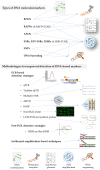DNA-Based Tools to Certify Authenticity of Rice Varieties-An Overview
- PMID: 35159410
- PMCID: PMC8834242
- DOI: 10.3390/foods11030258
DNA-Based Tools to Certify Authenticity of Rice Varieties-An Overview
Abstract
Rice (Oryza sativa L.) is one of the most cultivated and consumed crops worldwide. It is mainly produced in Asia but, due to its large genetic pool, it has expanded to several ecosystems, latitudes and climatic conditions. Europe is a rice producing region, especially in the Mediterranean countries, that grow mostly typical japonica varieties. The European consumer interest in rice has increased over the last decades towards more exotic types, often more expensive (e.g., aromatic rice) and Europe is a net importer of this commodity. This has increased food fraud opportunities in the rice supply chain, which may deliver mixtures with lower quality rice, a problem that is now global. The development of tools to clearly identify undesirable mixtures thus became urgent. Among the various tools available, DNA-based markers are considered particularly reliable and stable for discrimination of rice varieties. This review covers aspects ranging from rice diversity and fraud issues to the DNA-based methods used to distinguish varieties and detect unwanted mixtures. Although not exhaustive, the review covers the diversity of strategies and ongoing improvements already tested, highlighting important advantages and disadvantages in terms of costs, reliability, labor-effort and potential scalability for routine fraud detection.
Keywords: DNA barcoding; DNA-markers; PCR; SNPs; SSRs; adulteration; fraud; high-resolution melting; isothermal amplification; multiplex.
Conflict of interest statement
The authors declare no conflict of interest.
Figures





References
-
- United States Department of Agriculture Foreign Agricultural Services, PSD Reports, World Rice Production, Consumption and Stocks. [(accessed on 15 November 2021)];2022 January 12; Available online: https://apps.fas.usda.gov/psdonline/app/index.html#/app/downloads.
-
- Genesys. [(accessed on 15 November 2021)]. Available online: https://www.genesys-pgr.org/c/rice.
Publication types
Grants and funding
LinkOut - more resources
Full Text Sources

